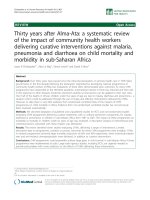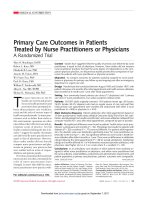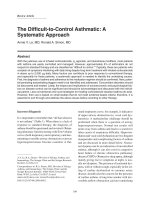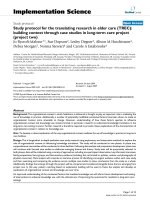Báo cáo y học: "Multidisciplinary care for tracheostomy patients: a systematic review" pdf
Bạn đang xem bản rút gọn của tài liệu. Xem và tải ngay bản đầy đủ của tài liệu tại đây (139.93 KB, 6 trang )
Open Access
Available online />Page 1 of 6
(page number not for citation purposes)
Vol 13 No 6
Research
Multidisciplinary care for tracheostomy patients: a systematic
review
Marie Garrubba
1
, Tari Turner
1
and Clare Grieveson
2
1
Centre for Clinical Effectiveness, Southern Health, Locked Bag 29, Clayton, Victoria 3168, Australia
2
Monash Medical Centre, Speech Pathology, Southern Health, Locked Bag 29, Clayton, Victoria 3168, Australia
Corresponding author: Marie Garrubba,
Received: 20 Jul 2009 Revisions requested: 22 Sep 2009 Revisions received: 22 Oct 2009 Accepted: 6 Nov 2009 Published: 6 Nov 2009
Critical Care 2009, 13:R177 (doi:10.1186/cc8159)
This article is online at: />© 2009 Garrubba et al.; licensee BioMed Central Ltd.
This is an open access article distributed under the terms of the Creative Commons Attribution License ( />),
which permits unrestricted use, distribution, and reproduction in any medium, provided the original work is properly cited.
Abstract
Introduction Appropriate care for patients with tracheostomies
in hospital settings is an important issue. Each year more than
7000 patients receive tracheostomies in Australia and New
Zealand alone. Many of these tracheostomy patients commence
their care in the intensive care unit (ICU) and once stabilised are
then transferred to a general ward. Insufficient skills and
experience of staff caring for tracheostomy patients may lead to
sub-optimal care and increased morbidity. The purpose of this
review was to identify whether multidisciplinary tracheostomy
outreach teams enable the reduction in time to decannulation
and length of stay in acute and sub-acute settings, improve
quality of care or decrease adverse events for patients with a
tracheostomy.
Methods We included all relevant trials published in English.
We searched Medline, CINAHL, All EBM and EMBASE in June
2009. Studies were selected and appraised by two reviewers in
consultation with colleagues, using inclusion, exclusion and
appraisal criteria established a priori.
Results Three studies were identified which met the study
selection criteria. All were cohort studies with historical controls.
All studies included adult patients with tracheostomies. One
study was conducted in the UK and the other two in Australia.
Risk of bias was moderate to high in all studies. All papers
concluded that the introduction of multidisciplinary care reduces
the average time to decannulation for tracheostomy patients
discharged from the ICU. Two papers also reported that
multidisciplinary care reduced the overall length of stay in
hospital as well as the length of stay following ICU discharge.
Conclusions In the papers we appraised, patients with a
tracheostomy tube in situ discharged from an ICU to a general
ward who received care from a dedicated multidisciplinary team
as compared with standard care showed reductions in time to
decannulation, length of stay and adverse events. Impacts on
quality of care were not reported. These results should be
interpreted with caution due to the methodological weaknesses
in the historical control studies.
Introduction
Appropriate care for patients with tracheostomies in hospital
settings is an important issue. Each year more than 7000
patients receive tracheostomies in Australia and New Zealand
alone [1]. Many of these tracheostomy patients commence
their care in the intensive care unit (ICU) and once stabilised
are transferred to a general ward. Insufficient skills and experi-
ence of staff caring for tracheostomy patients may lead to sub-
optimal care and increased morbidity.
To facilitate the improvement of care of patients with tracheos-
tomy, Southern Health, Clayton, Victoria, Australia, is inter-
ested in planning a multidisciplinary outreach service to care
for tracheostomy patients discharged from the ICU to the
wards. To inform this process the Centre for Clinical Effective-
ness was requested to undertake a systematic review to iden-
tify whether or not multidisciplinary tracheostomy outreach
teams compared with standard care enable the reduction in
time to decannulation and length of stay in acute and sub-
acute settings, improve quality of care or decrease adverse
events for these patients.
ENT: ear, nose and throat; ICU: intensive care unit; ITU: intensive treatment unit/intensive therapy unit; IQR: interquartile range; SCI: spinal cord injury;
SpR: specialist registrar; ST2: specialist trainee year 2; TMDT: tracheostomy multidisciplinary team; TRAMS: tracheostomy review and management
service.
Critical Care Vol 13 No 6 Garrubba et al.
Page 2 of 6
(page number not for citation purposes)
Materials and methods
Search strategy
In June 2009, we conducted a search for any comparative
study written in English from 1980 onwards. We searched
Medline using the following search strategy: (exp Tracheos-
tomy/OR exp Tracheotomy/OR (tracheostom$ OR trache-
otom$).mp. OR (trachea AND stoma).mp.) AND ((exp Patient
Care Team/OR "patient care team".mp.) OR exp "Continuity
of Patient Care"/OR exp Patient Care Planning/OR exp Case
Management/OR exp Patient Care Management/OR exp
"Delivery of Health Care, Integrated"/OR exp Patient-Cen-
tered Care/OR (Case-management OR care-coordination OR
care-co-ordination OR care-planning).mp. OR (Multidisciplin$
OR multi-disciplin$ OR multiprofessional OR multi-profes-
sional OR interdisciplin$ OR inter-disciplin$ OR (multi$ AND
profession$)).mp. OR (team$ OR service$).mp.)
Similar terms appropriately translated were used in EMBASE,
All EBM and CINAHL. Studies were selected and appraised
by two reviewers in consultation with colleagues using study
selection and appraisal criteria established a priori.
Inclusion criteria
The following inclusion criteria were applied to all studies iden-
tified.
Patient group included all tracheostomy patients, adults and/
or children, from any age group, in a hospital ward setting.
Intervention was multidisciplinary care. Comparator was
standard care. Outcomes were average time to decannulation,
length of stay, quality of care, and adverse events.
Quality assessment
The quality of included cohort studies was appraised using the
standard critical appraisal questions developed by the Centre
for Clinical Effectiveness. Critical appraisal questions are out-
lined in Table 1.
Missing data
Authors of included studies were contacted by email with any
queries.
Results
Search results
The search of all databases returned 1045 articles, which
were reviewed by title and abstract. When a decision could
not be made based on abstract alone, full text was retrieved. A
total of 59 full text articles were retrieved for review and three
articles met the inclusion criteria (Figure 1).
Three relevant studies were identified that met the study selec-
tion criteria. All were cohort studies with historical controls [2-
4]. Critical appraisals of the quality of the three cohort studies
are available [See additional data file 1].
All studies included adult patients with tracheostomies. One
study was conducted in the UK [2] and the other two in Aus-
tralia [3,4].
Study results
The first study was a historical cohort study including patients
with a tracheostomy discharged from an intensive treatment
unit (ITU) to a general ward at St. Mary's Hospital, Paddington,
London, UK. A total of 89 patients were included, of which 79
were the control group and 10 received the intervention. The
intervention included a weekly Tracheostomy Multidisciplinary
Team (TMDT) ward round (TMDT members included an ear
nose and throat Specialist Registrar (ENT SpR) and Specialist
Trainee Year 2 (ST2), speech and language therapist, respira-
tory physiotherapist and a critical care outreach nurse),
monthly teaching sessions organised for nursing staff involved
with tracheostomy care and an ENT-led training day for physi-
otherapists and speech and language therapists. This inter-
vention was compared retrospectively with standard care. The
study looked at the impact of the intervention on the following
outcomes: time to tracheostomy tube decannulation post-ITU
discharge, total time of tracheostomy (not defined, but we can
presume the definition of total time is inclusive of ITU and gen-
eral ward stay) and compliance with local tracheostomy care
guidelines (St. Mary's tracheostomy care bundle) between the
intervention group and a group of 70 patients of whom little
information is provided for selection criteria (this outcome was
therefore excluded from the appraisal of this paper).
The methods of this study were not well documented. Overall
we found the risk of bias in this study to be high. Inclusion and
exclusion criteria were not clearly documented; group similar-
ity was not achieved (eg 10-year mean age difference); meas-
urement of exposure and outcomes was not standardised,
valid or reliable; and there was some uncertainty about the per-
centage lost to follow up. Contributing to the high risk of bias
is the historical control study design. A historical control pro-
duces opportunities for bias, which can arise from the dissim-
ilarity between control and treatment groups, differences
between the hospital environment at the time of the interven-
tion and earlier conditions at the time of the historical control
and the difficulty in controlling for confounding.
The study found that "The mean time to decannulation follow-
ing ITU discharge was significantly reduced from 21 to 5 days
(P = 0.0005)" and that "The total tracheostomy time was
reduced from 34 to 24 days, although this difference was not
statistically significant (P = 0.13)".
The second study was also a historical cohort study including
ICU patients not under the care of an ENT unit who were dis-
charged to the ward with a tracheostomy at St. Vincent's Hos-
pital, Melbourne, Australia. A total of 280 patients were
included in the study of which 41 were the control group and
239 received the intervention over three years. The interven-
Available online />Page 3 of 6
(page number not for citation purposes)
tion in this study was an intensivist-led, multidisciplinary team
consisting of an intensivist, an ICU liaison nurse, a physiother-
apist, a speech pathologist and a dietitian. This team under-
took twice weekly ward rounds to review patients and to plan
and oversee an individualised tracheostomy weaning pro-
gramme. The intervention patients were compared with
patients who received standard care by a physiotherapist and
speech pathologist with ad hoc input from doctors prior to the
introduction of the intervention. The standard care in this study
appears to be multidisciplinary, but is not a dedicated service.
The study looked at decannulation time from ICU discharge as
its primary outcome and hospital length of stay, length of stay
Table 1
Critical appraisal questions for a cohort study
Description of the study
1. Patient/population
2. Number
3. Setting
4. Intervention
5. Comparison/control
6. Outcomes
7. Inclusion criteria
8. Exclusion criteria
Study validity
1. Were there any conflicts of interest in the writing or funding of this study?
2. Does the study have a clearly focused question?
3. Is a cohort study the appropriate method to answer this question?
4. Does the study have specified inclusion/exclusion criteria?
5. If there were specified inclusion/exclusion criteria, were these appropriate?
6. Other than the exposure under investigation, were the groups selected from similar populations?
7. Aside from the exposure, were the groups treated the same?
8. Was exposure measured in a standard, valid and reliable way?
9. Were outcome assessors blind to the exposure?
10. Were all outcomes measured in a standard, valid and reliable way?
11. Were outcomes assessed objectively and independently?
12. Is the paper free of selective outcome reporting?
13. Were the outcomes measured appropriate?
14. Was there sufficient duration of follow up?
15. Was the study sufficiently powered to detect any differences between the groups?
16. If statistical analysis was undertaken, was this appropriate?
17. Were the groups similar at baseline with regards to key prognostic variables?
18. What percentage of the individuals recruited into each arm of the study were lost to follow up?
19. What percentages of the individuals were not included in the analysis?
Other
1. What is the overall risk of bias?
Results
Authors' conclusions
Our comments
Critical Care Vol 13 No 6 Garrubba et al.
Page 4 of 6
(page number not for citation purposes)
after ICU discharge and length of stay of less than 43 days
(the upper trim point for the disease-related group code for tra-
cheostomy) as secondary outcomes.
The methods of this study were fairly well documented, but
some methodological weaknesses may affect the conclusions
of the study. The study presents patient groups chosen from
similar populations; however, the difference in the size of the
control versus intervention group is substantial (n = 41 and n
= 239, respectively) and the larger group may include a wider
range of patient types. Both groups were reportedly treated
the same with the exception of the patients in the third year
(2006) of the intervention group whose results may have been
affected by the introduction of a nurse liaison service. Despite
the study reporting similar populations and treatment of
patients between the control and intervention groups, the his-
torical control study design introduces the potential for
unknown confounders and historical factors that may have
affected the results.
It appears that measurement of outcomes were not standard-
ised, valid or reliable. There was no loss to follow up with all
patients being included in the final analysis.
The study had three findings. (1) The median hospital length of
stay decreased over the study period from 42 (interquartile
range (IQR): 29 to 73) days to 34.5 (IQR: 26 to 53) days (P =
0.06). (2) The median hospital stay after ICU discharge was
reduced in 2006 compared with 2003, from 30 (IQR: 13 to
52) days to 19 (IQR: 10 to 34) days (P < 0.05). This data was
provided for the comparison between 2006 and 2003 only.
Statistical significance was not reported for other intervention
years. (3) There was a significant trend to reduced decannula-
tion times from ICU discharge (P < 0.01) across the four years
of the study, although absolute difference between the years
was not statistically significant (P = 0.06).
The third study was a historical cohort study (matched pairs
design) including spinal cord injury (SCI) patients with a tra-
cheostomy tube in-situ discharged to wards at the Austin Hos-
pital, Melbourne, Australia. A total of 34 patients were
recruited and analysed in the pre-Tracheostomy Review and
Management Service (TRAMS) arm of the study, while 53
patients were recruited to the post-TRAMS arm. Of the 53
patients, 34 were matched by level of SCI, injury severity and
age to the controls (pre-TRAMS) and included in the analysis.
The intervention was a TRAMS introduced as a consultative
team of respiratory and ICU doctors, clinical nurse consult-
ants, physiotherapists and speech pathologists. The service
included: twice weekly ward rounds by the TRAMS team for all
ward-based patients with a tracheostomy tube (except ENT in-
patients); patient consultations on other days as needed;
patient support, and education of ward staff; regular assess-
ment of patient readiness for decannulation; support of
patients with a long-term tracheostomies in the community,
with equipment, consumables, tube changes and education;
tracheostomy resource and equipment library; implementation
and review of interdisciplinary tracheostomy policy and proce-
dures; critical incident review and delivery of interdisciplinary
tracheostomy education. This intervention was compared with
pre-TRAMS care within the Victorian Spinal Cord Service at
Austin Health. The study looked at the impact of TRAMS on
the following outcomes: length of acute hospital stay, duration
of cannulation, improved communication through use of one-
way valve, adverse events and related costs.
The methods of this study were fairly well documented. Over-
all, we found the risk of bias in this study to be moderate.
The authors did not report any conflicts of interest in the writ-
ing or funding of the study or whether outcomes were meas-
ured in a standard, valid and reliable way. It was also unclear if
outcomes were assessed objectively and independently, and
if participants had sufficient duration of follow up. A large per-
centage of patients (46%) from the post-TRAMS group were
excluded from the analysis as well as 13% from the pre-
TRAMS group (See details in Additional data file 1). Contrib-
uting to the moderate risk of bias is the lack of information pro-
vided for the methods of matching the post-TRAM patients to
Figure 1
Number of studies includedNumber of studies included. Key reasons for exclusion: 1 = not a com-
parative study; 2 = irrelevant setting; 3 = irrelevant intervention; 4 =
irrelevant comparator; 5 = irrelevant outcomes. Search flow chart: n =
number of studies.
Available online />Page 5 of 6
(page number not for citation purposes)
the pre-TRAM patients. The lack of information around the
method of matching opens this paper to potential bias
because it is unclear whether the researchers could influence
the choice of patients to be matched. Similarly with all histori-
cal cohort studies there is a possibility that other factors may
have influenced the tracheostomy care of SCI patients either
positively or negatively.
The study found that the median length of acute hospital stay
was reduced from 60 to 41.5 days (P = 0.03) with the median
duration of cannulation also reduced from 22.5 to 16.5 days
(P = 0.03). These results were both statistically significant.
The post-TRAMS group reported no adverse events as com-
pared with the two tracheostomy related code-blue calls for
the pre-TRAMS group.
Discussion
All papers included in this review came to the conclusion that
the introduction of multidisciplinary care reduces the average
time to decannulation for tracheostomy patients discharged
from the ICU to a general ward setting. Two papers [3,4] also
reported that multidisciplinary care reduced the overall length
of stay in hospital, as well as the length of stay from ICU dis-
charge. Although these results are encouraging, the historical
control design presents a significant potential for bias in all
studies. Studies designed around a historical control are open
to bias from many angles. The dissimilarities between the con-
trol and treatment group, whether demographic, diagnostic
criteria, stage and severity of disease, simultaneous treat-
ments, and differences in observational and data collection
conditions, can affect outcomes. Similarly, the time difference
between control and intervention groups can introduce differ-
ences other than the intervention; for example, change in treat-
ment patterns (eg protocols, guidelines, and changes in
staffing) and other exposures that are unknown to data collec-
tors or not recorded in medical records. All of these variables
have the potential to affect the results of the studies appraised.
Multidisciplinary care is a complex intervention that is difficult
to evaluate due to its multiple and varying components. All
appraised studies presented different descriptions of multidis-
ciplinary care including different collaborations of disciplines.
Therefore, it is difficult to infer the combination of disciplines
that should make up the most appropriate multidisciplinary
care team for tracheostomy patients.
It should be noted that in these studies [2-4] the multidiscipli-
nary teams were led by different specialists: an intensivist, an
ENT specialist and a respiratory physician, respectively. This is
important because it may limit the generalisability of multidisci-
plinary teams for tracheostomy care as we are unable to tell
whether the effects reported were due to the dedicated 'tra-
cheostomy' feature, the multidisciplinary nature of the care or
the medical and specialist nature of the leadership.
Multidisciplinary tracheostomy teams are now widespread in
national and international health services and are seen to be
the most appropriate model of care for tracheostomy patients
[2-7]. This review suggests that although there is some evi-
dence that a specialised, multidisciplinary tracheostomy team
may be beneficial; however, this evidence is limited and high-
quality evidence from well-controlled studies including data on
complication rates and adverse events is still needed to con-
vincingly determine the effectiveness of a multidisciplinary
team for tracheostomy patients.
Given the potential for bias in the studies reviewed the results
should be interpreted with care.
Conclusions
In the papers we appraised, patients with a tracheostomy tube
in situ discharged from an ICU to a general ward who received
care from a dedicated multidisciplinary team as compared with
standard care showed improvements in time to decannulation,
length of stay and adverse events. The effects of the interven-
tion on quality of care were not reported. These results may be
applicable to the Southern Health setting; however, should be
actioned with caution due to the methodological weaknesses
presented in the historical control studies.
Competing interests
The authors declare that they have no competing interests.
Authors' contributions
CG requested the systematic review from the Centre for Clin-
ical Effectiveness and provided clinical expertise and interpre-
tation. With assistance from CG, MG and TT developed the
Key messages
• Multidisciplinary tracheostomy teams are now wide-
spread in national and international health services and
are seen to be the most appropriate model of care for
tracheostomy patients.
• High-quality evidence from well-controlled studies is still
needed to convincingly determine the effectiveness of a
multidisciplinary team for tracheostomy patients.
• All papers included in this review came to the conclu-
sion that the introduction of multidisciplinary care
reduces the average time to decannulation for tracheos-
tomy patients discharged from the ICU to a general
ward setting.
• Two papers reported that multidisciplinary care reduced
the overall length of stay in hospital as well as the length
of stay from ICU discharge.
• Generalisability of multidisciplinary teams for tracheos-
tomy care is limited as all three teams were led by differ-
ent specialists; an intensivist, an ENT specialist and a
respiratory physician.
Critical Care Vol 13 No 6 Garrubba et al.
Page 6 of 6
(page number not for citation purposes)
search strategy. MG applied inclusion criteria to search results
in consultation with TT. MG appraised the three included
papers. TT was a second review for all included papers. MG
prepared the first draft of this article which TT and CG then
reviewed.
Authors' information
MG is a Clinical Effectiveness Project Officer at the Centre for
Clinical Effectiveness, Southern Health. TT is a Clinical Effec-
tiveness Senior Consultant at the Centre for Clinical Effective-
ness, Southern Health. CG is the Manager of Speech
Pathology at Southern Health.
Additional files
Acknowledgements
Our thanks to Dr Claire Harris for comments during the development
and drafts of this systematic review.
References
1. The Health Roundtable []
2. Arora A, Hettige R, Ifeacho S, Narula A: Driving standards in tra-
cheostomy care: A preliminary communication of the St Mary's
ENT-led multi disciplinary team approach. Clinical Otolaryngol-
ogy 2008, 33:596-599.
3. Tobin A, Santamaria J: An intensivist-led tracheostomy review
team is associated with shorter decannulation time and length
of stay: a prospective cohort study. Critical Care 2008,
12:R48-R48.
4. Cameron TS, McKinstry A, Burt SK, Howard ME, Bellomo R,
Brown DJ, Ross JM, Sweeney JM, O'Donoghue FJ: Outcomes of
patients with spinal cord injury before and after introduction of
an interdisciplinary tracheostomy team. Crit Care Resusc
2009, 11:14-19.
5. Hunt K, McGowan S: Tracheostomy management in the neuro-
sciences: a systematic, multidisciplinary approach. Brit J Neu-
rosci Nursing 2005, 1:122-125.
6. Mace A, Patel N, Mainwaring F: Current standards of tracheos-
tomy care in the UK. Otorhinolaryngologist 2006, 1:37-39.
7. Parker V, Archer W, Shylan G, McMullen P: Trends and chal-
lenges in the management of tracheostomy in older people:
the need for a multidisciplinary team approach. Contemporary
Nurse: A Journal for the Australian Nursing Profession 2007,
26:177-183.
The following Additional files are available online:
Additional file 1
A pdf file containing the critical appraisal tables of all
three included studies.
See />supplementary/cc8159-S1.PDF









